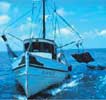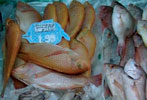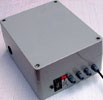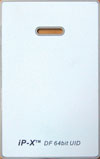

Fisheries are playing an increasingly important role in the global food industry, as the need to feed the growing global population is moving towards the world's oceans.
According to Food and Agriculture Organization (FAO) statistics the total fish production in the world in 2001 was 130 million tonnes. In addition to the commercial catches, 37,9 million tonnes were produced in aquaculture plants.1 The global seafood market is estimated at US$100 billion per year, with world per capita consumption at present about 16 kg2. The increase in world demand is estimated at 0,5-3,0% per year. On average, this means additional annual requirements of 650 000 tonnes in the EU and 250 000 tonnes in the US.
China is the world's top fishing nation. Since the beginning of 1980s, China's output of marine catches has been continuously growing. According to the statistics of 1996, there were more than 280 000 Chinese fishing vessels involved in marine catches with a total output of 11,22 million tonnes. The US fishing and seafood industry consists of 25 000 commercial fishing vessels; 700 fish processors, and 2800 distributors, with a final commercial value of $14 billion. The major seafood importing markets are Japan, US and European Union (EU). These markets depend on imports for 40-60% of their seafood consumption.

The need for RFID in the fisheries value chain
New traceability legislation came into force in January 2005 in both the EU (Article 18 of EU Regulation 178) and US (the US Bio-terrorism Act 2002) that creates a requirement for high integrity supply chains in all food industries. Increased cost-pressures are leading to globalisation not only of food retailers but also of suppliers. A new generation of global food supplier must learn how to efficiently operate truly global supply chains.
A number of widely publicised issues, from health to animal protection, cross-subsidisation of agriculture and the exploitation of employees are requiring suppliers and retailers to increasingly take social responsibility - traceability is a fundamental requirement to respond to these. Industry leaders expect the adoption of radio frequency tagging (RFID) to play a key role in overcoming the above challenges.3 For these reasons the food industry is indeed proving to be one of the early global adopters of RFID.
Specific requirements of the fisheries industry include the ability to manage multiple food grading levels as well as the management of the cold chain for perishables. To improve accuracy and efficiency in the fisheries industry, raw fish must be traced from trawlers, through the public auction system, into the processing plant, from where goods are dispatched through the global supply chain.

Unique offering to the fisheries industry
Passive UHF RFID, and more specifically the EPC Gen 2 implementation, has received much attention as a solution for managing global supply chains, including the food industry. There are, however, fundamental limitations inherent to UHF RFID that prevents providing reliable traceability of foods and beverages, due to high moisture content of most food products - this is very much the case in the fish industry. HF RFID, operating at 13,56 MHz, does not really offer a viable alternative due to its very limited read range.
Ipico's unique dual frequency (DF) technology is fast proving to be the only passive RFID technology that can overcome all technological challenges posed by the global food industry. The primary competitive edge of DF is the ability to read tags through high levels of humidity at ranges that are long enough to support logistics processes without causing any disruption, from fishing trawlers to the retail shelf. This functionality can be maintained even in the very harsh and unfriendly environments that are typical of the fisheries industry. Combining this capability with the robust iP-X anti-collision protocol results in an industry winner.
A complete DF RFID solution for the fisheries industry will include the following elements:
* Tags affixed to bins used to transport fish from trawlers through the auction process to processing plants, with readers integrated onto forklifts or installed as portals.
* Readers embedded into the floor of fish processing plants to control the movement of different grades of fish from grading stations through the buffering area to production lines.
* Portals installed throughout the logistics chain to track the final product at pallet and case level, with tags embedded into packaging materials.
In all of these scenarios DF RFID will provide 100% visibility, irrespective of the presence of seawater on the plant floor and high moisture levels in unfrozen product, and regardless of packing configurations used for pallets and forklifts. No other passive RFID technology can equal this set of capabilities.

Case study
The most critical part of the food supply chain, where the most value can be added by RFID, is in the food processing plant itself. Mistakes made at this level, typically due to the erroneous identification of batches in process, will result not only in high levels of wastage but also the creation of health hazards. It therefore made a lot of sense for Ipico to target fish processing plants as first point of entry into the fisheries industry. The Sea Harvest project focused on the processing plant as a starting point, aiming to accurately control the grade of fish that is fed into specific production lines.
The Ipico system involved the installation of 26 DF read stations at different positions in the buffering area where fish is channelled from the grading stations into a number of parallel production lines. To fit into the existing operational process flow, the reader antennae had to be embedded into the factory floor, where it is exposed to regular flow of seawater, sub-zero temperatures as well as high electro-magnetic noise levels created by neon lighting and variable speed induction motors. 700 fish tubs were equipped with robustly packaged DF tags that are read through the fish and seawater inside the tubs. No other passive RFID technology could satisfy this requirement or match the DF capability.
The system includes 11 closely spaced Grader Read Stations that identify tubs after the contents are graded, with a requirement of no spurious cross reads among these stations. Tubs are then moved past a Buffer Validation Reader before being moved into the buffer zone. From the buffer zone the tubs are fetched on demand and transported to one of 11 Hopper Stations, where the Hopper Read Stations have to verify the identity of each tub before the fish is being fed into the correct production line. On their way back into the closed loop in-plant supply chain, the tubs are once more identified into the washing area using a Wash Bay Reader.
The system was commissioned at the end of January 2006, and has been running faultlessly since then. The Ipico RFID system has been interfaced with the In Touch SCADA system from Wonderware and state-of-the-art Scanvaegt automated fish grading equipment. 100% accuracy has been obtained with this system once the software system was debugged.
This solution is now planned for roll-out into the global fisheries industry, requiring hundreds of thousands of tubs and thousands of read stations. Future work will include upstream integration of the system to trace tubs from fish trawlers through the auction system, as well as downstream managing the cold supply chain for fish products. Similar concepts are also planned for other food processing plants where DF can offer unique benefits.

The future of RFID in fisheries
DF RFID is the technology of the future to create and preserve value in fisheries supply chains -
* To provide compliance with traceability regulations.
* To manage quality in processing plants.
* To ensure fast and accurate logistics processes.
* To reduce wastage and improve quality in retail by managing expiry dates.
* To maximise retail sales through the availability of the right product at the right time.
For more information contact Ipico, +27 (0)12 349 0442, [email protected], www.ipico.co.za
1. http://en.wikipedia.org/wiki/Fishing_industry
2. http://www.firstresearch.com/Industry-Research/Commercial-Fishing-and-Seafood-Distribution
3. Deloitte/SAP Food Industry White Paper: What's Hot in the Food Industry? A view from SAP and Deloitte, 2004.

© Technews Publishing (Pty) Ltd. | All Rights Reserved.